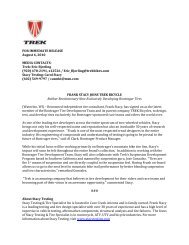Airfoil Development for the Trek Speed Concept ... - Slowtwitch.com
Airfoil Development for the Trek Speed Concept ... - Slowtwitch.com
Airfoil Development for the Trek Speed Concept ... - Slowtwitch.com
Create successful ePaper yourself
Turn your PDF publications into a flip-book with our unique Google optimized e-Paper software.
APPENDIX<br />
1 Aerodynamic Drag in Cycling<br />
Aerodynamic drag generally has two <strong>com</strong>ponents: pressure drag and skin friction drag. In cycling, pressure drag is caused by flow<br />
separation and <strong>the</strong> resulting low pressure wake behind <strong>the</strong> airfoil. The pressure differential from <strong>the</strong> front to <strong>the</strong> rear of <strong>the</strong> airfoil<br />
creates a <strong>for</strong>ce in <strong>the</strong> opposite direction to <strong>the</strong> airfoil’s motion (think of a vacuum sucking <strong>the</strong> rear of <strong>the</strong> airfoil backwards.) Flow<br />
separation also generates vortices and/or turbulence, both additional sources of energy dissipation. Skin friction drag is a <strong>for</strong>ce caused<br />
by <strong>the</strong> air traveling (shearing) across <strong>the</strong> skin of <strong>the</strong> airfoil.<br />
1.1 Flow Separation and Boundary Layers<br />
Traditional bicycle airfoils are extremely susceptible to flow separation, resulting in very high pressure drag [12, 13], as was illustrated<br />
in Figures 15 and 18. One way to delay flow separation (make <strong>the</strong> separation point occur far<strong>the</strong>r towards <strong>the</strong> tail of <strong>the</strong> airfoil) is to<br />
turn <strong>the</strong> boundary layer from laminar to turbulent. A turbulent boundary layer has more momentum and thus resists separating from<br />
<strong>the</strong> airfoil wall [8], as shown in <strong>the</strong> figure below. A laminar boundary layer can be turned turbulent using various turbulence-inducing<br />
features, such as dimples.<br />
Figure 24: Laminar and turbulent<br />
boundary layer profiles [8].<br />
However, flow separation is a symptom of an inherently high-drag airfoil. While a turbulent boundary layer might reduce pressure<br />
drag, it will increase skin friction drag [14]. In cases where <strong>the</strong> flow separation (pressure drag) is severe enough, <strong>the</strong> tradeoff results<br />
in a net reduction of drag. Obviously, an airfoil which can avoid this tradeoff altoge<strong>the</strong>r is ideal. The KVF was designed to behave like<br />
a large aspect ratio airfoil with very little or no flow separation. So, <strong>the</strong> KVF minimizes pressure drag without <strong>the</strong> aid of a turbulent<br />
boundary layer (high shear drag), resulting in <strong>the</strong> lowest possible total drag.<br />
20
















